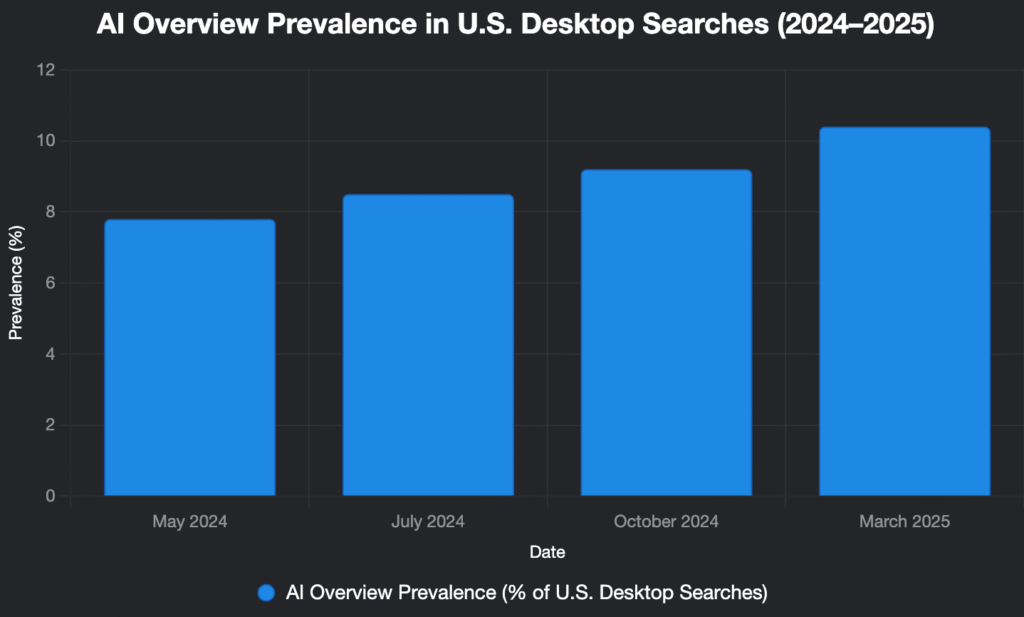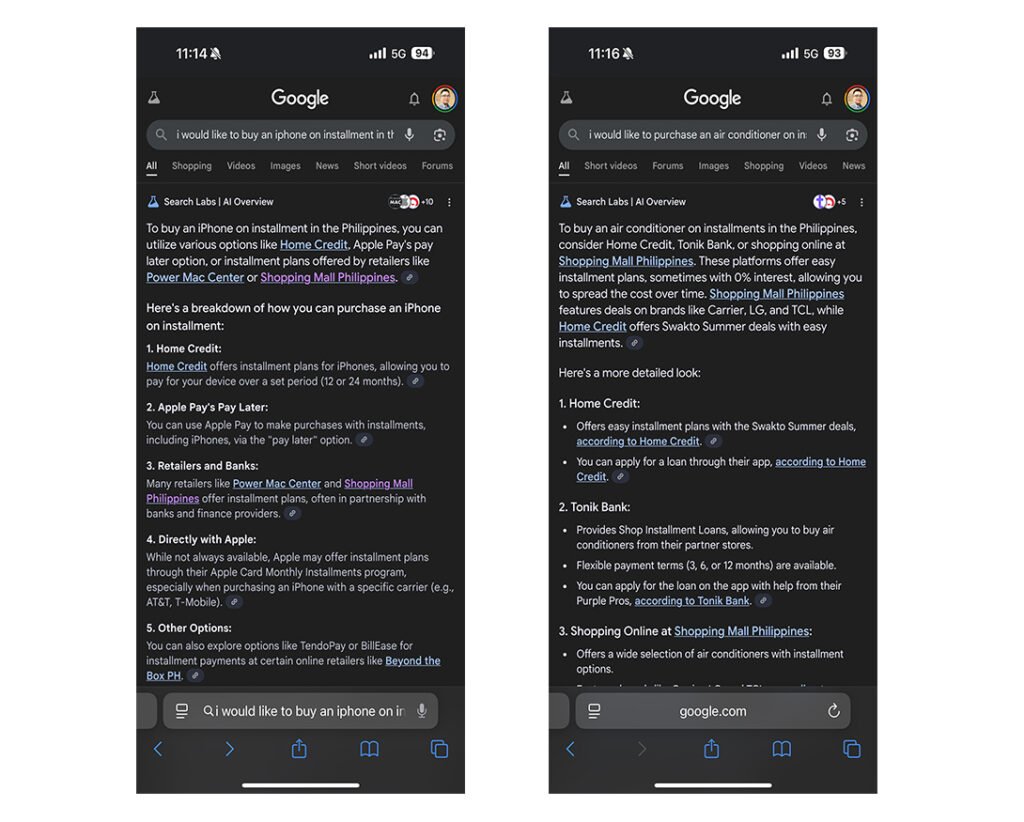Table of Contents
The 2025 Google I/O event brought groundbreaking changes to the digital marketing landscape, with Google’s AI-driven feature taking center stage. This technology, which provides concise summaries atop search results, is transforming how users access information, presenting both challenges and opportunities for businesses. For marketing professionals, CMOs, CDOs, and CEOs, understanding these updates from Google’s 2025 conference is essential to staying competitive in an AI-driven search era.
This article explores the latest advancements in AI-generated answers, announced at the 2025 Google I/O event, examines their impact on search strategies, and offers practical steps to adapt. We’ve included a chart showing the growth of Google’s AI feature, a comparison of optimization strategies, an infographic placeholder, and FAQs to address your questions. Let’s dive into how these developments can shape your marketing approach.
Key Updates to AI Overview at Google I/O 2025
Global Reach and Its Implications
At the 2025 Google I/O event on May 20, 2025, Google announced significant advancements to its AI-driven feature that delivers answers directly on search result pages. Powered by the Gemini 2.5 model, this technology now serves 1.5 billion monthly users across 200+ countries and 40+ languages. By March 2025, it appeared in 10.4% of U.S. desktop searches, up from 7.8% in May 2024.
This global rollout reflects Google’s commitment to seamless search experiences. The feature compiles information from various sources, often answering user queries without requiring a click to a website. For businesses, this means rethinking how to maintain visibility. For example, a small e-commerce store in France might now compete with global brands for attention in AI summaries, especially in markets newly exposed to this technology. The expansion also opens opportunities for multilingual content strategies, as brands can now reach audiences in 40+ languages with tailored messaging.
New Features Enhancing Search Experiences
Google’s 2025 conference introduced impactful updates to its AI feature, making it a cornerstone of modern search. The new AI Mode, launched in the U.S., offers personalized answers with adjustable detail levels, such as “Simpler” or “Break it Down.” Deep Search, available through Search Labs, provides detailed responses for complex queries—think “how does quantum computing impact cybersecurity?”—with comprehensive breakdowns. Visual search now includes videos, enhancing the user experience with dynamic content.
E-commerce businesses benefit from the integration with Google’s Shopping Graph, enabling features like virtual try-ons and price tracking. For instance, a user searching “best running shoes 2025” might see an AI summary with product images, prices, and a try-on option, all without leaving the search page. Local searches also see improvements, with tailored results featuring reviews and business details. A café in Seattle, for example, could appear in an AI summary with its star rating, hours, and a map link, directly influencing customer decisions. These enhancements make search more engaging but require businesses to adapt their strategies to align with AI-driven trends.
Critical Statistics on AI Overview’s Impact
Data Highlighting Changes in Search
The rise of AI-generated answers is reshaping how search functions, with data underscoring its influence. Below is a table of key statistics, followed by a chart illustrating its growth.
| Statistics | Description | Source |
|---|---|---|
| 10.4% of U.S. desktop searches include AI Overviews | As of March 2025, 10.4% of U.S. desktop searches feature AI Overviews. | seoClarity |
| 4.5% drop in top position click-through rates | AI Overviews reduce click-through rates for #1 organic listings by 34.5%. | Search Engine Land |
| 8.9% of transactional queries trigger AI Overviews | Transactional searches show AI Overviews in 8.9% of cases as of March 2025. | seoClarity |
| 0.14% of local searches include AI Overviews | Local searches trigger AI Overviews in 0.14% of cases as of March 2025. | seoClarity |
| 99.5% of sources from top 10 results | 99.5% of AI Overview sources are drawn from Google’s top 10 organic results. | seoClarity |
The 34.5% drop in click-through rates signals a major shift for search strategies, while the 99.5% correlation with top results shows that strong SEO foundations remain important.
Tracking AI Overview’s Growth (2024–2025)
The bar chart below shows the increasing presence of Google’s AI feature in U.S. desktop searches from May 2024 to March 2025.

This chart highlights a 33% increase in AI Overview’s prevalence, from 7.8% to 10.4%. X posts note it may appear in up to 54.61% of high-volume searches, showing its growing influence.
How AI Overview Challenges Search Strategies
The Decline of Organic Traffic
AI-generated answers deliver responses directly on the search page, leading to “zero-click” searches. This reduces the traffic potential of keywords to less than 0.7%, a significant shift from the click-driven model of the past. For example, a user searching “best CRM software 2025” might find a list of options in the AI summary, bypassing the need to visit a review site.
The 34.5% drop in click-through rates for top rankings impacts industries like health, finance, and news the most. Competition for remaining clicks intensifies, as users often stop at the AI summary. Smaller businesses face hurdles, as the technology typically sources from the top 10 organic results, favoring established players.
New Metrics for Success in Search
Despite these challenges, the sources for AI summaries align with organic rankings, with 99.5% coming from top 10 results. This suggests that solid SEO foundations are still valuable, but new metrics are emerging. Being cited in AI summaries is now as critical as driving clicks. Tools like seoClarity and Semrush are starting to track visibility in AI-generated answers, though Google Search Console offers limited data.
Platforms like Perplexity and ChatGPT, which favor conversational queries (averaging 23 words versus Google’s 4.2), further complicate the landscape. For instance, a query like “What are the best strategies for improving website conversions in 2025?” might yield a detailed response on Perplexity without directing users to a website. Businesses must adapt to these trends to stay relevant.
The Shift in User Behavior
Another layer of complexity is the change in user behavior. With AI summaries providing quick answers, users are less likely to scroll through multiple results. This trend is particularly evident in mobile searches, where the feature’s prevalence has surged by 119% since 2024. Marketers must now prioritize content that aligns with user intent at the moment of search, ensuring their information is concise, authoritative, and easily digestible by AI algorithms.
While at Home Credit Philippines, I was fortunate that our emphasis was on enhancing our website’s technical aspects and prioritizing traditional SEO. With Google launching its AI Overview in the Philippines, we began observing promising outcomes as Google AI began suggesting our loan products to customers seeking installment purchases.

Comparing SEO Strategies in the AI Era
Understanding Different Approaches
As search evolves, three strategies—SEO, Answer Engine Optimization (AEO), and Generative Engine Optimization (GEO)—offer distinct ways to maintain visibility. The table below outlines their differences and applications.
| Aspect | Traditional SEO | Answer Engine Optimization (AEO) | Generative Engine Optimization (GEO) |
|---|---|---|---|
| Definition | Optimizing websites for higher rankings in search engine results pages. | Optimizing content for direct answers in featured snippets or AI Overview. | Optimizing for visibility in AI-driven generative responses across platforms. |
| Similarities | Enhances visibility and traffic; relies on high-quality content and keyword research. | Enhances visibility and traffic; relies on high-quality content and keyword research. | Enhances visibility and traffic; relies on high-quality content and keyword research. |
| Differences | Focuses on rankings, click-through rates, and backlinks for traditional SERPs. | Targets concise answers for snippets and AI Overview; emphasizes clarity and structure. | Prioritizes citations, statistics, and topical authority for AI search outputs. |
| When to Use | Ideal for e-commerce, broad organic reach, and competitive keywords. | Best for informational queries, FAQs, and securing AI Overview placements. | Suited for AI search platforms, long-tail queries, and generative responses. |
SEO drives broad reach, AEO secures visibility in AI summaries, and GEO targets AI platforms. A balanced approach maximizes impact.
Why a Hybrid Strategy Works Best
Combining these strategies allows businesses to cover all bases. For example, an e-commerce brand might use SEO to rank for “best laptops 2025,” AEO to appear in AI summaries for “what to look for in a laptop,” and GEO to ensure their content is cited in conversational AI responses on platforms like ChatGPT. This hybrid approach ensures visibility across different search contexts, from traditional results to AI-driven platforms.
Business Implications of AI Overview
Challenges to Traffic and Revenue
The zero-click searches driven by AI summaries reduce website visits, impacting industries like health, news, and e-commerce. The 34.5% drop in click-through rates for top rankings leads to fewer conversions, potentially costing significant revenue. Transactional queries (8.9% with AI-generated answers) and local searches (0.14%) are increasingly affected, challenging retailers and local businesses.
Smaller organizations struggle, as the technology favors authoritative sources, often from top organic results. For example, a local health blog might lose traffic to larger medical sites like WebMD, which are more likely to be cited in AI summaries. This shift highlights the need for new strategies to maintain visibility.
Industry-Specific Impacts
Certain sectors feel the impact more acutely. In the health industry, users seeking quick answers—like “symptoms of a cold”—often find them in AI summaries, reducing visits to healthcare websites. In finance, queries like “best investment strategies 2025” might lead to summaries that pull from major publications, sidelining smaller financial advisors. News outlets face similar challenges, as breaking news snippets in AI summaries can satisfy user curiosity without driving clicks to articles. These trends underscore the urgency for businesses to adapt their content strategies.
Case Study: A Retailer’s Response
Consider a mid-sized online retailer specializing in outdoor gear. Before the rise of AI summaries, they relied on SEO to rank for terms like “best hiking boots.” Now, with click-through rates dropping, they’ve shifted focus to creating content that answers specific user questions, such as “What are the best hiking boots for beginners?” This content, structured with clear headings and schema markup, has increased their chances of being cited in AI-generated answers, driving targeted traffic despite fewer clicks.
Opportunities for Enhanced Visibility
Despite these challenges, AI summaries create opportunities. Being cited in an AI-generated answer can boost brand authority and drive targeted traffic, even for sites not ranking highly. For instance, a niche blog on sustainable fashion might gain exposure by being cited in a summary for “eco-friendly clothing brands 2025.” Establishing a presence on YouTube, Google Business Profiles, and industry forums also strengthens trust signals, a key factor in modern search rankings. These platforms allow businesses to showcase expertise and engage with audiences directly, enhancing their chances of being featured in AI-driven results.
Strategies to Thrive with AI Overview
Optimizing for AI Overview Inclusion
To succeed with Google’s AI feature, create content that its algorithms can easily summarize. Use high-quality, structured content with clear headings and schema markup to highlight relevance. Address user queries directly, focusing on informational and long-tail keywords that trigger AI summaries. For example, a blog post titled “How to Choose the Best CRM Software in 2025” could include a section answering “What features should I look for in a CRM?” in a concise, bullet-point format.
Earn citations by publishing unique insights or data, as AI-generated answers prioritize authoritative sources. Tools like Gemini or ChatGPT can analyze competitor content to identify gaps. For instance, if competitors lack detailed comparisons of CRM software pricing, your content could fill that gap, increasing citation likelihood. Additionally, ensure your website is technically optimized—fast load times, mobile-friendliness, and secure connections (HTTPS) signal reliability to search algorithms.
Leveraging Generative Engine Optimization
Generative Engine Optimization (GEO) focuses on optimizing for AI-driven outputs across platforms. Build topical authority with in-depth content clusters around industry topics. A fitness brand, for example, could create a series of articles covering nutrition, exercise routines, recovery techniques, and fitness gear reviews, establishing itself as a go-to resource. This comprehensive approach signals expertise to AI models, improving the chances of being cited in generative responses.
Use tools like Semrush Market Explorer to align content with user intent. For instance, if data shows users are searching for “low-impact workouts for seniors,” create content that directly addresses this need. Cross-channel trust signals, such as social media engagement, forum mentions, and guest posts on reputable sites, also enhance GEO performance. A fitness brand might collaborate with a health influencer on Instagram to discuss their content, boosting visibility and credibility across platforms.
Preparing for Broader AI Platforms
Beyond Google, platforms like ChatGPT and Perplexity are gaining traction. Develop conversational content to answer complex queries effectively. For example, a travel agency could create a guide answering “What’s the best itinerary for a 7-day trip to Japan?” in a conversational tone, mirroring how users might ask an AI chatbot. Video content is also critical, as visual search integration pulls in YouTube results. A video titled “Japan Travel Guide: 7-Day Itinerary” could complement the written guide, increasing visibility.
Track visibility in AI summaries using tools like seoClarity or Semrush’s AI Overviews Tracker. For e-commerce, maintain accurate product data and reviews to appear in shopping-focused results. A travel agency, for instance, could ensure its tour packages are listed with detailed descriptions, pricing, and customer testimonials, making them more likely to be featured in AI-driven shopping summaries. A multi-faceted strategy ensures long-term success across diverse platforms.
Building a Future-Ready Content Strategy
To stay ahead, adopt a proactive approach to content creation. Regularly audit your website to identify content gaps and opportunities for improvement. For example, use Google Analytics to see which pages have high bounce rates and update them with more relevant, user-focused content. Invest in training for your marketing team to understand AI-driven search trends, ensuring they’re equipped to implement GEO and AEO strategies effectively. Finally, consider partnering with AI experts or agencies to stay informed about the latest developments in search technology, ensuring your business remains competitive as algorithms evolve.
FAQs on AI Overview and Search Strategies
-
What is Google’s AI feature, and why was it highlighted at the 2025 Google I/O event?
Google’s AI feature provides summaries atop search results. At the 2025 Google I/O event, its expansion to 1.5 billion users and new features like AI Mode highlighted its role in modern search, urging businesses to adapt
-
How does AI Overview affect search strategies?
AI summaries cut click-through rates by 34.5%, as users find answers without visiting sites. While strong rankings help (99.5% of sources are top 10 results), businesses must optimize for citations in AI-generated answers to stay visible
-
What distinguishes SEO, AEO, and GEO?
SEO boosts organic rankings, AEO targets AI summaries and snippets, and GEO optimizes for AI platforms. Use SEO for broad reach, AEO for answers, and GEO for generative responses, blending all for maximum impact
-
How can businesses prepare for AI platforms?
Develop conversational content for platforms like Perplexity, prioritize video, and track visibility in AI summaries with tools like Semrush. Build trust through cross-channel engagement to compete in the AI ecosystem
-
What industries are most affected by AI Overview?
Health, finance, and news industries see the biggest impact, as users find quick answers in AI summaries, reducing visits to websites. E-commerce and local businesses are also affected, needing new strategies
-
How can small businesses compete with larger brands in AI summaries?
Small businesses can compete by creating niche, high-quality content that answers specific user queries, earning citations in AI-generated answers. Building trust through local engagement and reviews also helps
Conclusion: Positioning for Success in Modern Search
The 2025 Google I/O event marked a pivotal moment, with AI-generated answers driving a 10.4% prevalence and a 34.5% click-through rate decline, challenging conventional strategies. Yet, opportunities abound for businesses adapting to these changes. By creating high-quality content, tracking visibility in AI summaries, and aligning marketing efforts, organizations can thrive. Looking ahead, staying informed about AI-driven search trends will be key to maintaining a competitive edge. As search technology continues to evolve, businesses that invest in adaptive strategies now will be well-positioned to lead in the future. Take action today to ensure your brand excels in this new era.
Read my other article “Winning with Google AI Overviews: Top SEO Strategies for 2025“.









